 |
| Search |
|
|

|
 |
Western & Northern Africa Database
Clash with Fast Eagles
The US monitored the developments related with Libyan with great concern, and already in mid-February 1981, a carrier battle group (CVBG) of the US 6th Fleet "exercised" for several days only some 80kms away from Benghazi, apparently conducting several reconnaissance operations in the area.
In August 1981, the US administration deployed two CVBGs - one lead by the carrier USS Forrestal (CV-59), and another by USS Nimitz (CVN-68) - off the Libyan coast, with the official explanation, that the ships and their aircraft were to conduct live missile-firing exercises, and also exercise the right of free passage through waters considered as international by the Americans, but „territorial“ by the Libyans.
 |
| One of the first Libyan MiG-25P (export)s intercepted by the USN fighters on the 18 August 1981 was "7003", shown here together with the full armament of two R-40s and four R-60s. (USN) |
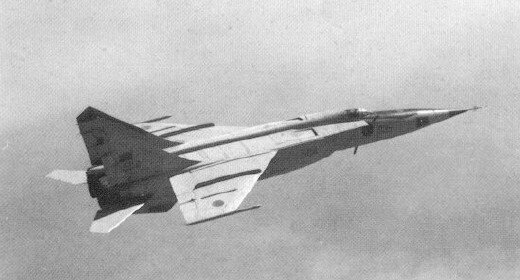 |
| One of a pair of LARAF MiG-25RBs, intercepted by USN fighters on the morning of 18 August. The plane was possibly flown by a Soviet pilots, for which it was known to have manned a single squadron of Libyan MiG-25s. (USN) |
As soon as the exercise started, on 18 August 1981, the LARAF forward-deployed the 1015th Sqn with MiG-25PDs to Misurata AB, and then began to dispatch a high number of interceptors and fighter-bombers towards US carriers. Early on the morning, at least one MiG-25RB and two MiG-25PDs approached US CVBGs, but both were escorted away by F-4S’ (VF-11 and VF-31 flew the type from Forrestal) and F-14As (VF-41 and VF-84 flew the type from Nimitz) of US carriers. Subsequently, the LARAF obviously tried to establish the exact position of US carriers slightly better due to earlier reconnaissance, the LARAF dispatched no less but 35 pairs of MiG-23MS, MiG-25PDs, Su-20Ms, Su-22M-2/3Ks and Mirage F.1s into the area. These were all - one after the other - successively „intercepted“ by a total of seven pairs of Tomcats and Phantoms, which kept a watchfull eye (and several cameras) on any Libyan moves.
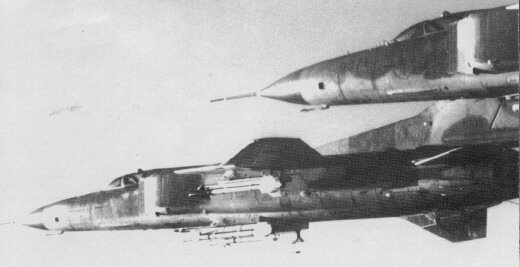 |
| As more LARAF fighters were turned away by USN interceptors on 18 August, the tensions lessened somewhat, and in some casess USN fliers came "really" close to the Libyans, which enabled them to shot pictures like this one, offering a fine study of the front part y of two LARAF MiG-23MS. (USN) |
 |
| On 18 August 1981 the USN fighters intercepted also a pair of LARAF Mirage F.1EDs, including the example "515", shown here. (USN) |
The situation was tense, but no weapons were used, even if in at least two cases MiG-25s tried to „breach“ the positions of USN interceptors, by flying high and very fast.
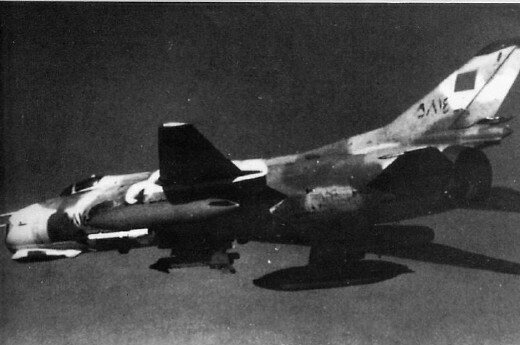 |
| LARAF Su-20M, "5814", armed with two K-13M missiles. (USN) |
 |
| LARAF Su-22M-3K, like one of two examples intercepted and shot down by „Fast Eagles“, on 18 August 1981. Libyans made extensive use of their Sukhois as interceptors during these engagements. |
 |
| "Fast Eagle 102" being guided towards one of the two catapults aboard the USS Nimitz (CVN-68). (USN) |
This changed early the next morning, when an E-2C of the VAW-124 detected two Libyan fighters taking off from the Ghurdabiya-Sirte AB, and moving north at high speed. Two Tomcats - actually belonging to two different CAP-pairs - were sent to intercept, in what was expected to be an exact copy of similar events from the previous day. However, shortly before the two formations passed by each other, the lead Libyan Su-22 apparently fired a K-13M missile towards the lead Tomcat. A controversy developed subsequently if the Libyan indeed fired a missile, or jettisoned a tank, which then - due to the fuel streaming out of it - looked like a missile, but the USN pilots were not to stop the Libyans and ask any questions. As the Sukhois flashed by, both Tomcats turned hard port, reached favorable positions and started to fire AIM-9L Sidewinders. The Libyan leader was shot down by the Tomcat wingman, the „Fast Eagle 102“, and the Libyan wingman was shot down by the leader of the US formation and CO VF-41, Lt.Cdr. Henry Kleeman, which flew as „Fast Eagle 107“. Both Libyan pilots ejected, and were apparently recovered by Libyan rescue teams.
 |
| Above and bellow: "Fast Eagle 107", one of the two VF-41 F-14As which took part in the intercept of two LARAF Su-22M-3Ks on the morning of 18 August 1981. Note the single "kill-marking" under the front cockpit (a small black Su-22-silhouette).(Photo: USN; Artwork: Tom Cooper) |
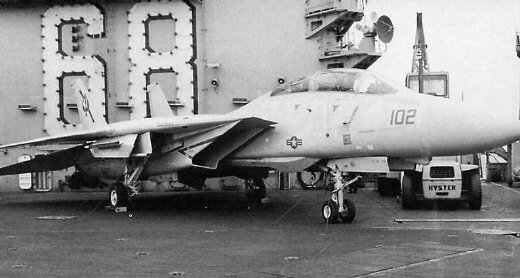 |
| "Fast Eagle 102" as seen on the morning of 19 August 1981, underneath the bridge of USS Nimitz CVN-68. (USN) |
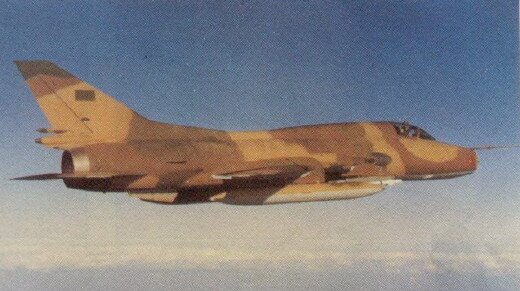 |
| Another LARAF Su-22M-2K, this time from the starboard side and without any serial. It seems that the Soviets have painted the Su-22s delivered to Libya in all possible camouflage pattern: no two aircraft looked even similar. (USN |
Hardly one hour later, however, while the recovery operation was still underway, two fully armed MiG-25s of the 1015th Squadron LARAF entered the airspace over the Gulf of Sirte and took a course towards the US Task Force, trying to pass to the west of the nearest pair of F-14s and thus starting what was to become both - an excellent demonstration of a brute power of the Foxbat, but also the capabilities of the AWG-9. The Libyans approached at Mach 1.5 and first did a mock attack in the direction of the carrier USS Nimitz but were then turned around by two VF-41 Tomcats and an F-14A of the VF-84, which all acquired them with the AWG-9s. Upon intercept, the Foxbats made a few mild 360 degrees turns and then appeared to be returning to base. The Tomcats broke off, but then had to intercept them again when Libyans steadied up on an easterly heading again. After a new acquisition by AWG-9 and „burning“ the ears of Libyan pilots for some time, the MiGs finally engaged their afterburners, turned to the West and climbed away. Except for one more Libyan formation, which approached the US CVBGs later in the day, this was the last confrontation between US and LARAF fighters for several years.
 |
| Four VF-41 fliers that participated in the short dogfight with two LARAF Su-22s on 19 August. From left to right: Lt. James Anderson, Lt. Larry Muczynski, Lt. Dave Venlet, Cdr. Henry Kleeman (CO VF-41). (Tom Cooper collection) |
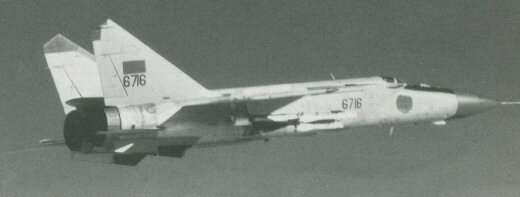 |
| Another LARAF MiG-25P (export): note the full armament, consisting of a pair of R-40 (AA-6 Acrid) and four R-60 (AA-8 Aphid) air-to-air missiles. (USN) |
Until today it remains unsure who flew these two MiG-25s in such an aggressive manner. However, in the same evening, the Libyan TV showed interviews with two LARAF pilots, including Maj. Khaled Maeena, who reported that the had personally „chased away six American Navy F-14 bombers... back to their carrier“, and that the USN fighters „had been on their way to attack many Libyan cities.“ Major Maeena then went on to first „thank Libyan’s leader Khadaffi..“, and also „...the people of Russia for supplying him with the MiG-25, which allowed him to defend his homeland from the American aggressor warplanes by shooting all six down as they tried to land and hide on their carriers.“ It can be assumed, that Major Maeena was one of the MiG-25-pilots engaged by USN F-14s on that day.
© Copyright 2002-3 by ACIG.org
Top of Page
|
|
 |
Latest Western & Northern Africa Database
|
|
Cote d'Ivoire, since 2002
|
|
Sierra Leone, 1990-2002
|
|
Portfolio: Algerian Air Force thru History
|
|
Burkina Faso and Mali, Agacher Strip War, 1985
|
|
Libyan Wars, 1980-1989, Part 6
|
|
Libyan Wars, 1980-1989, Part 5
|
|
Libyan Wars, 1980-1989, Part 4
|
|
Libyan Wars, 1980-1989, Part 3
|
|
Libyan Wars, 1980-1989, Part 2
|
|
Libyan Wars, 1980-1989, Part 1
|
|
Libya & Egypt, 1971-1979
|
|
Morocco, Mauritania & West Sahara since 1972
|
|
Civil War in Nigeria (Biafra), 1967-1970
|
|
Guiné (Portuguese Guinea), 1959-1974
|
|
Algerian War, 1954 - 1962
|

|